python自動(dòng)化測(cè)試三部曲之request+django實(shí)現(xiàn)接口測(cè)試
國(guó)慶期間準(zhǔn)備寫三篇博客,介紹和總結(jié)下接口測(cè)試,由于國(guó)慶期間帶娃,沒有按照計(jì)劃完成,今天才完成第二篇,慚愧慚愧。
這里我第一篇博客的地址:https://www.jb51.net/article/197004.htm,主要是介紹unittest框架,有興趣的同學(xué)們可以移步去查閱
這里廢話少說,進(jìn)入正題
我的思路是這樣的
1、先用django實(shí)現(xiàn)登陸、增加、刪除、查看4個(gè)接口
2、在excel定義好測(cè)試案例、然后讀取excel中的案例,然后把案例用unittest框架組裝和封裝
3、啟動(dòng)django,執(zhí)行測(cè)試案例
一、先跑通unittest到django的流程
1、先創(chuàng)建一個(gè)Django的項(xiàng)目
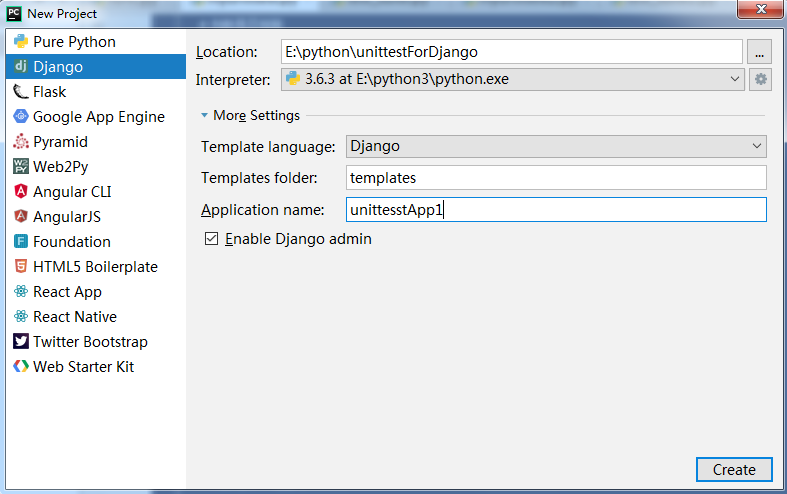
2、創(chuàng)建路由,這里我們使用二級(jí)路由
a、先復(fù)制工程目錄下的urls.py文件到app目錄下
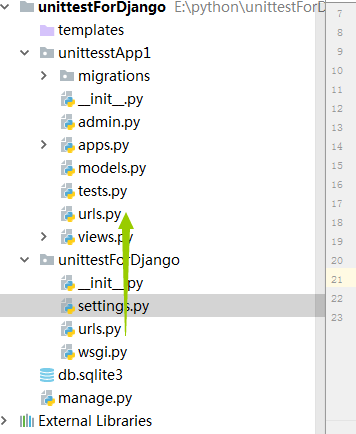
b、修改工程目錄下的urls.py文件,定義一級(jí)路由
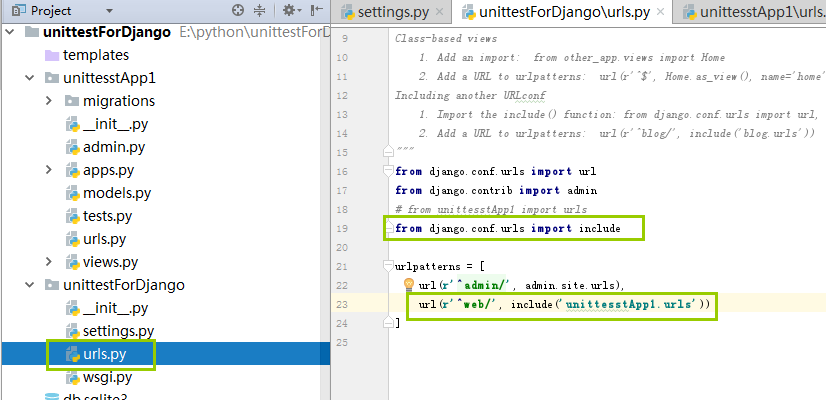
c、修改app目錄下的urls.py文件,設(shè)置二級(jí)路由,這里切記務(wù)必要?jiǎng)h除默認(rèn)的admin這條路由
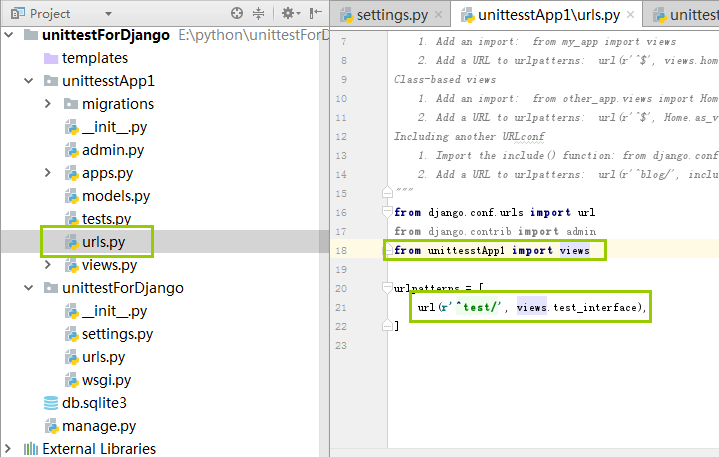
d、定義這條路由指向的視圖的函數(shù)

e、啟動(dòng)django,這里我們使用9090端口啟動(dòng),因?yàn)槲覀兊腏enkins端口用的是8080
E:pythonunittestForDjango>python manage.py runserver 9090
f、這里的是啟動(dòng)成功的樣式,我圈住的告警可以忽略,因?yàn)檫@里Django的admin需要的,我們這里不會(huì)用到django的admin

g、打開瀏覽器訪問django,我們的一個(gè)簡(jiǎn)單的Django項(xiàng)目已經(jīng)跑通

3、在視圖函數(shù)中定義一個(gè)方法,這個(gè)方法分別處理GET請(qǐng)求和POST請(qǐng)求
a、定義視圖函數(shù)
這里通過這個(gè)參數(shù)告訴瀏覽器,我們返回的是JSON數(shù)據(jù)
return HttpResponse(result, content_type='application/json;charset=utf-8')
def test_login(request): method = request.method.upper() if method == 'GET': result = {} name = request.GET.get('username',None) pwd = request.GET.get('pwd',None) result['name'] = name result['pwd'] = pwd result = json.dumps(result) # return HttpResponse(result) return HttpResponse(result, content_type='application/json;charset=utf-8') else: result = {} name = request.POST.get('username',None) pwd = request.POST.get('pwd',None) result['name'] = name result['pwd'] = pwd result = json.dumps(result) return HttpResponse(result,content_type='application/json;charset=utf-8')
b、使用request模塊發(fā)起POST和GET請(qǐng)求
#Auther Bob#--*--conding:utf-8 --*--import requestsimport jsonclass TestCase(object): def __init__(self,username,pwd,url): self.username = username self.pwd = pwd self.url = url def get(self): # 發(fā)送get請(qǐng)求 url = self.url + '?username=' + str(self.username) + '&' + 'pwd=' + str(self.pwd) res = requests.get(url=url) print(res.text,type(res.text)) def post(self): # 發(fā)送post請(qǐng)求 data = { 'username' : self.username, 'pwd' : self.pwd } res = requests.post(url=self.url,data=data) print(res.text)if __name__ == ’__main__’: url = 'http://127.0.0.1:9090/web/login/' username = 'zhangsan' pwd = '123' t = TestCase(username,pwd,url) t.get() t.post()
c、這里我們引入unittest框架,測(cè)試案例可以這么寫
import unittestfrom test3 import test_requestclass TestDjango(unittest.TestCase): def setUp(self): print('unittest框架的前置條件') def tearDown(self): print('unittest框架的后置條件') def test_01(self): url = 'http://127.0.0.1:9090/web/login/' username = 'zhangsan' pwd = '123' t = test_request.TestCase(url=url,username=username,pwd=pwd) def test_02(self): url = 'http://127.0.0.1:9090/web/login/' username = 'zhangsan' pwd = '123' t = test_request.TestCase(url=url,username=username,pwd=pwd) t.post()if __name__ == ’__main__’: unittest.main(verbosity=2)
d、這里有重復(fù)代碼,我們可以利用unittest框架中的classmethod來解決,因?yàn)閷?shí)例化一個(gè)測(cè)試類可以放在前置條件中
import unittestfrom test3 import test_requestclass TestDjango(unittest.TestCase): @classmethod def setUpClass(cls): url = 'http://127.0.0.1:9090/web/login/' username = 'zhangsan' pwd = '123' # 這里的t雖然是類變量,但是python的中的實(shí)例是可以用引用類變量的 cls.t = test_request.TestCase(url=url,username=username,pwd=pwd) def setUp(self): print('unittest框架的前置條件') def tearDown(self): print('unittest框架的后置條件') def test_01(self): self.t.get() def test_02(self): self.t.post()if __name__ == ’__main__’: unittest.main(verbosity=2)
e、在testcase中加入斷言
import unittestfrom test3 import test_requestclass TestDjango(unittest.TestCase): @classmethod def setUpClass(cls): url = 'http://127.0.0.1:9090/web/login/' username = 'zhangsan' pwd = '123' # 這里的t雖然是類變量,但是python的中的實(shí)例是可以用引用類變量的 cls.t = test_request.TestCase(url=url,username=username,pwd=pwd) def setUp(self): print('unittest框架的前置條件') def tearDown(self): print('unittest框架的后置條件') def test_01(self): res = self.t.get() self.assertEqual(200,res.status_code) def test_02(self): res = self.t.post() self.assertEqual(200, res.status_code)if __name__ == ’__main__’: unittest.main(verbosity=2)
f、引入testsuite
import unittestfrom unittest import TestLoaderfrom test3 import test_unittestif __name__ == ’__main__’: suite = unittest.TestSuite() loader = TestLoader() test_cases1 = unittest.TestLoader().loadTestsFromModule(test_unittest) # 參數(shù)是一個(gè)模塊,會(huì)把這個(gè)模塊里的所有case加載進(jìn)來 suite.addTests(test_cases1) runner = unittest.TextTestRunner(verbosity=2) runner.run(suite)
二、在django中設(shè)計(jì)接口
這里我們寫一個(gè)簡(jiǎn)單的例子,設(shè)計(jì)一個(gè)用戶表,設(shè)計(jì)4個(gè)接口
接口1:登陸
接口2:增加用戶,需要用戶登陸
接口3:刪除用戶,需要用戶登陸
接口4:查詢用戶,不需要用戶登陸
1、先看登陸接口
a、登錄接口對(duì)應(yīng)的url
下面是一級(jí)路由
url(r’^web/’, include(’unittesstApp1.urls’))
下面是二級(jí)路由
url(r’^login/’, views.test_login),
b、登錄接口的視圖函數(shù)
def test_login(request): method = request.method.upper() if method == 'GET': returndict = {'code': 200, 'error': None} username = request.GET.get('username',None) password = request.GET.get('password',None) if username == 'admin' and password == 'admin123.': request.session['username'] = username request.session['password'] = password result = json.dumps(returndict) else: returndict['code'] = 201 returndict['error'] = '用戶名或者密碼錯(cuò)誤' result = json.dumps(returndict) return HttpResponse(result,content_type='application/json;charset=utf-8')
這里我們用到了session來代替cookies
2、增加用戶接口
a、增加用戶對(duì)應(yīng)的url
一級(jí)路由同登陸接口,下面是二級(jí)路由
url(r’^add/’, views.test_add),
b、增加用戶接口對(duì)應(yīng)的視圖函數(shù),這里我們做了各種異常處理,且判斷了用戶是否登陸,也就是通過是否攜帶cookies來判斷
def test_add(request): method = request.method.upper() if method == 'POST': returndict = {'code': 200, 'error': None} username = request.session.get('username',None) password = request.session.get('password',None) if username == 'admin' and password == 'admin123.': newusername = request.POST.get('username',None) age = request.POST.get('age',None) sex = request.POST.get('sex',None) pwd = request.POST.get('pwd',None) userinfo = [newusername,age,sex,pwd] print(userinfo) if not 'None' in userinfo and all(userinfo):if models.userInfo.objects.filter(username = userinfo[0]).exists(): returndict['error'] = '{username} is exists,please add a new username'.format(username = username) returndict['code'] = 201 result = json.dumps(returndict) return HttpResponse(result, content_type='application/json;charset=utf-8')else: models.userInfo.objects.create( username = newusername, age = age, sex = sex, pwd = pwd ) if models.userInfo.objects.filter(username=userinfo[0]).exists(): result = json.dumps(returndict) return HttpResponse(result, content_type='application/json;charset=utf-8') else: returndict['error'] = '{username} is error,please retry add'.format(username=username) returndict['code'] = 201 result = json.dumps(returndict) return HttpResponse(result, content_type='application/json;charset=utf-8') else:returndict['error'] = 'must input username,age,sex,pwd'returndict['code'] = 201result = json.dumps(returndict)return HttpResponse(result, content_type='application/json;charset=utf-8') else: returndict = {'code': 201, 'error': '用戶名或者密碼錯(cuò)誤'} result = json.dumps(returndict) return HttpResponse(result, content_type='application/json;charset=utf-8')
3、刪除接口
a、刪除用戶對(duì)應(yīng)的url
一級(jí)路由同登陸接口,這里只看二級(jí)路由
url(r’^del/’, views.del_user),
b、刪除接口對(duì)應(yīng)的視圖函數(shù),這里我做了各種異常處理,也做了用戶是否登陸的檢測(cè),也是通過檢測(cè)cookies來實(shí)現(xiàn)
def del_user(request): method = request.method.upper() if method == 'POST': returndict = {'code': 200, 'error': None} username = request.session.get('username',None) password = request.session.get('password',None) if username == 'admin' and password == 'admin123.': delusername = request.POST.get('username',None) print(delusername) if delusername != None:if models.userInfo.objects.filter(username=delusername).exists(): delid = models.userInfo.objects.get(username=delusername).id print(delid) try: models.userInfo.objects.get(id=delid).delete() except Exception as e: returndict = {'code': 201, 'error': e} result = json.dumps(returndict) return HttpResponse(result, content_type='application/json;charset=utf-8') else: result = json.dumps(returndict) return HttpResponse(result, content_type='application/json;charset=utf-8')else: returndict = {'code': 201, 'error': '{username} is not exists'.format(username = delusername)} result = json.dumps(returndict) return HttpResponse(result, content_type='application/json;charset=utf-8') else:returndict = {'code': 201, 'error': 'you must input a username'}result = json.dumps(returndict)return HttpResponse(result, content_type='application/json;charset=utf-8') else: returndict = {'code': 201, 'error': 'username or password is error'} result = json.dumps(returndict) return HttpResponse(result, content_type='application/json;charset=utf-8')
4、查看接口
a、查看接口對(duì)應(yīng)的url
一級(jí)路由同登陸接口url,下面是二級(jí)路由
url(r’^scan/’, views.get_user),
b、查看接口對(duì)應(yīng)的url,這里我們不檢測(cè)用戶是否登陸,直接把查到的數(shù)據(jù)返回給客戶,如果查詢報(bào)錯(cuò),才返回錯(cuò)誤的信息
def get_user(request): method = request.method.upper() returndict = {'code': 200, 'userinfo': None} if method == 'GET': try: alluser = models.userInfo.objects.all().values_list('username') alluserlist = [] for i in alluser:alluserlist.append(i) returndict['userinfo'] = alluserlist except Exception as e: returndict['code'] = '201' returndict['error'] = e finally: result = json.dumps(returndict) return HttpResponse(result, content_type='application/json;charset=utf-8')
5、設(shè)計(jì)刪除數(shù)據(jù)庫中所有的接口,用來做后置條件
def del_alluser(request): method = request.method.upper() if method == 'POST': returndict = {'code': 200, 'error': None} username = request.session.get('username', None) password = request.session.get('password', None) if username == 'admin' and password == 'admin123.': if models.userInfo.objects.all().count() > 0:models.userInfo.objects.all().delete() result = json.dumps(returndict) return HttpResponse(result, content_type='application/json;charset=utf-8')
三、案例準(zhǔn)備
1、在excel中寫好接口測(cè)試案例

2、定義常量,也就是每列對(duì)應(yīng)的值
class TestConfig(object): def __init__(self): self.name = 0 self.url = 1 self.method = 2 self.cookies = 3 self.data = 4 self.res = 5 self.exec = 6 def getname(self): return self.name def geturl(self): return self.url def getmethod(self): return self.method def getcookies(self): return self.cookies def getdata(self): return self.data def getres(self): return self.res def getexec(self): return self.exec
3、定義讀取excel的類,因?yàn)槲乙獜膃xcel中讀取案例
import xlrdimport osclass testexcel(object): casepath = os.path.join(os.path.dirname(os.path.dirname(os.path.abspath(__file__))), 'case', 'testcase.xlsx') def __init__(self): self.casepath = testexcel.casepath self.execlobj = xlrd.open_workbook(self.casepath) self.sheetobj = self.execlobj.sheet_by_index(0) def get_excel_data(self,row,col): max_row = self.get_excel_max_row() max_col = self.get_excel_max_col() if row > max_row -1 or col > max_col - 1: return False else: data = self.sheetobj.cell_value(row,col) return data def get_excel_max_row(self): r_num = self.sheetobj.nrows return r_num def get_excel_max_col(self): c_num = self.sheetobj.ncols return c_num
4、定義我們的接口函數(shù)
import requestsimport jsonclass TestLogin(object): def __init__(self,username,pwd,url): self.username = username self.pwd = pwd self.url = url def get(self): # 發(fā)送get請(qǐng)求 url = self.url + '?username=' + str(self.username) + '&' + 'password=' + str(self.pwd) res = requests.get(url=url, headers={ 'user-agent': 'Mozilla/5.0 (Windows NT 6.1) AppleWebKit/537.36 (KHTML, like Gecko) Chrome/57.0.2987.133 Safari/537.36' }) # print(json.loads(res.text)) return res def post(self): # 發(fā)送post請(qǐng)求 data = { 'username' : self.username, 'pwd' : self.pwd } res = requests.post(url=self.url, data=data, headers={'user-agent': 'Mozilla/5.0 (Windows NT 6.1) AppleWebKit/537.36 (KHTML, like Gecko) Chrome/57.0.2987.133 Safari/537.36' }, ) # print(res.text) return resclass TestAdd(object): def __init__(self,username,age,sex,pwd,cookies,url): self.username = username self.age = age self.sex = sex self.pwd = pwd self.url = url self.cookies = cookies def post(self): # 發(fā)送post請(qǐng)求 data = { 'username' : self.username, 'pwd' : self.pwd, 'age' : self.age, 'sex' : self.sex } res = requests.post(url=self.url, data=data, headers={'user-agent': 'Mozilla/5.0 (Windows NT 6.1) AppleWebKit/537.36 (KHTML, like Gecko) Chrome/57.0.2987.133 Safari/537.36' }, cookies=self.cookies, ) # print(res.text) return resclass Testdel(object): def __init__(self, username,cookies,url): self.username = username self.cookies = cookies self.url = url def post(self): # 發(fā)送post請(qǐng)求 data = { 'username': self.username, } res = requests.post(url=self.url, data=data, headers={'user-agent': 'Mozilla/5.0 (Windows NT 6.1) AppleWebKit/537.36 (KHTML, like Gecko) Chrome/57.0.2987.133 Safari/537.36' }, cookies=self.cookies, ) # print(res.text) return resclass Testscan(object): def __init__(self,url): self.url = url def get(self): res = requests.get(url=self.url, headers={'user-agent': 'Mozilla/5.0 (Windows NT 6.1) AppleWebKit/537.36 (KHTML, like Gecko) Chrome/57.0.2987.133 Safari/537.36' }, cookies=None, ) return res
5、定義測(cè)試案例
import unittestfrom test3 import test_requestimport jsonfrom util import test_jsonfrom util import test_excelfrom case import testconfigimport requestsclass TestDjango(unittest.TestCase): @classmethod def setUpClass(cls): cls.alldata = test_json.testjson() @classmethod def tearDownClass(cls): url = 'http://127.0.0.1:9090/web/login/' + '?username=' + 'admin' + '&' + 'password=' + 'admin123.' res = requests.get(url=url, headers={ 'user-agent': 'Mozilla/5.0 (Windows NT 6.1) AppleWebKit/537.36 (KHTML, like Gecko) Chrome/57.0.2987.133 Safari/537.36' }) url = 'http://127.0.0.1:9090/web/delall/' requests.post(url=url, headers={ 'user-agent': 'Mozilla/5.0 (Windows NT 6.1) AppleWebKit/537.36 (KHTML, like Gecko) Chrome/57.0.2987.133 Safari/537.36' }, cookies = res.cookies ) def get_cookies(self): url = 'http://127.0.0.1:9090/web/login/' + '?username=' + 'admin' + '&' + 'password=' + 'admin123.' res = requests.get(url=url, headers={ 'user-agent': 'Mozilla/5.0 (Windows NT 6.1) AppleWebKit/537.36 (KHTML, like Gecko) Chrome/57.0.2987.133 Safari/537.36' }) # print(json.loads(res.text)) return res.cookies @unittest.skip(’noexec’) def test_login_ok(self): row = 1 configobj = testconfig.TestConfig() excelobj = test_excel.testexcel() execstatus = excelobj.get_excel_data(row,configobj.getexec()) if execstatus == 'YES': cookiesstatus = excelobj.get_excel_data(row, configobj.getcookies()) if cookiesstatus == 'YES':cookies = self.get_cookies() else:cookies = None data = excelobj.get_excel_data(row, configobj.getdata()) data = json.loads(data) url = excelobj.get_excel_data(row, configobj.geturl()) res = excelobj.get_excel_data(row, configobj.getres()) method = excelobj.get_excel_data(row, configobj.getmethod()) if method == 'GET':testobj = test_request.TestLogin(data['username'],data['pwd'],url)resobj = testobj.get()self.assertEqual(int(res),json.loads(resobj.text)['code']) @unittest.skip(’noexec’) def test_login_pwd_error(self): row = 2 configobj = testconfig.TestConfig() excelobj = test_excel.testexcel() execstatus = excelobj.get_excel_data(row,configobj.getexec()) if execstatus == 'YES': cookiesstatus = excelobj.get_excel_data(row, configobj.getcookies()) if cookiesstatus == 'YES':cookies = self.get_cookies() else:cookies = None data = excelobj.get_excel_data(row, configobj.getdata()) data = json.loads(data) url = excelobj.get_excel_data(row, configobj.geturl()) res = excelobj.get_excel_data(row, configobj.getres()) method = excelobj.get_excel_data(row, configobj.getmethod()) if method == 'GET':testobj = test_request.TestLogin(data['username'],data['pwd'],url)resobj = testobj.get()self.assertEqual(int(res),json.loads(resobj.text)['code']) @unittest.skip(’noexec’) def test_login_user_error(self): row = 3 configobj = testconfig.TestConfig() excelobj = test_excel.testexcel() execstatus = excelobj.get_excel_data(row,configobj.getexec()) if execstatus == 'YES': cookiesstatus = excelobj.get_excel_data(row, configobj.getcookies()) if cookiesstatus == 'YES':cookies = self.get_cookies() else:cookies = None data = excelobj.get_excel_data(row, configobj.getdata()) data = json.loads(data) url = excelobj.get_excel_data(row, configobj.geturl()) res = excelobj.get_excel_data(row, configobj.getres()) method = excelobj.get_excel_data(row, configobj.getmethod()) if method == 'GET':testobj = test_request.TestLogin(data['username'],data['pwd'],url)resobj = testobj.get()self.assertEqual(int(res),json.loads(resobj.text)['code']) @unittest.skip(’noexec’) def test_user_pwd_error(self): row = 4 configobj = testconfig.TestConfig() excelobj = test_excel.testexcel() execstatus = excelobj.get_excel_data(row,configobj.getexec()) if execstatus == 'YES': cookiesstatus = excelobj.get_excel_data(row, configobj.getcookies()) if cookiesstatus == 'YES':cookies = self.get_cookies() else:cookies = None data = excelobj.get_excel_data(row, configobj.getdata()) data = json.loads(data) url = excelobj.get_excel_data(row, configobj.geturl()) res = excelobj.get_excel_data(row, configobj.getres()) method = excelobj.get_excel_data(row, configobj.getmethod()) if method == 'GET':testobj = test_request.TestLogin(data['username'],data['pwd'],url)resobj = testobj.get()self.assertEqual(int(res),json.loads(resobj.text)['code']) @unittest.skip(’noexec’) def test_insert_ok(self): row = 5 configobj = testconfig.TestConfig() excelobj = test_excel.testexcel() execstatus = excelobj.get_excel_data(row, configobj.getexec()) if execstatus == 'YES': cookiesstatus = excelobj.get_excel_data(row, configobj.getcookies()) if cookiesstatus == 'YES':cookies = self.get_cookies() else:cookies = None data = excelobj.get_excel_data(row, configobj.getdata()) data = json.loads(data) url = excelobj.get_excel_data(row, configobj.geturl()) res = excelobj.get_excel_data(row, configobj.getres()) method = excelobj.get_excel_data(row, configobj.getmethod()) if method == 'POST':testobj = test_request.TestAdd(data['username'], data['age'],data['sex'], data['pwd'],cookies,url)resobj = testobj.post()print(json.loads(resobj.text))self.assertEqual(int(res), json.loads(resobj.text)['code']) @unittest.skip(’noexec’) def test_insert_nologin(self): row = 6 configobj = testconfig.TestConfig() excelobj = test_excel.testexcel() execstatus = excelobj.get_excel_data(row, configobj.getexec()) if execstatus == 'YES': cookiesstatus = excelobj.get_excel_data(row, configobj.getcookies()) if cookiesstatus == 'YES':cookies = self.get_cookies() else:cookies = None data = excelobj.get_excel_data(row, configobj.getdata()) data = json.loads(data) url = excelobj.get_excel_data(row, configobj.geturl()) res = excelobj.get_excel_data(row, configobj.getres()) method = excelobj.get_excel_data(row, configobj.getmethod()) if method == 'POST':testobj = test_request.TestAdd(data['username'], data['age'],data['sex'], data['pwd'],cookies,url)resobj = testobj.post()print(json.loads(resobj.text))self.assertEqual(int(res), json.loads(resobj.text)['code']) @unittest.skip('noexec') def test_insert_user_error(self): row = 7 configobj = testconfig.TestConfig() excelobj = test_excel.testexcel() execstatus = excelobj.get_excel_data(row, configobj.getexec()) if execstatus == 'YES': cookiesstatus = excelobj.get_excel_data(row, configobj.getcookies()) if cookiesstatus == 'YES':cookies = self.get_cookies() else:cookies = None data = excelobj.get_excel_data(row, configobj.getdata()) data = json.loads(data) url = excelobj.get_excel_data(row, configobj.geturl()) res = excelobj.get_excel_data(row, configobj.getres()) method = excelobj.get_excel_data(row, configobj.getmethod()) if method == 'POST':testobj = test_request.TestAdd(data.get('username',None), data.get('age',None), data.get('sex',None), data.get('pwd',None), cookies, url)resobj = testobj.post()print(json.loads(resobj.text))self.assertEqual(int(res), json.loads(resobj.text)['code']) @unittest.skip(’no exec’) def test_insert_pwd_error(self): row = 8 configobj = testconfig.TestConfig() excelobj = test_excel.testexcel() execstatus = excelobj.get_excel_data(row, configobj.getexec()) if execstatus == 'YES': cookiesstatus = excelobj.get_excel_data(row, configobj.getcookies()) if cookiesstatus == 'YES':cookies = self.get_cookies() else:cookies = None data = excelobj.get_excel_data(row, configobj.getdata()) data = json.loads(data) url = excelobj.get_excel_data(row, configobj.geturl()) res = excelobj.get_excel_data(row, configobj.getres()) method = excelobj.get_excel_data(row, configobj.getmethod()) if method == 'POST':testobj = test_request.TestAdd(data.get('username',None), data.get('age',None), data.get('sex',None), data.get('pwd',None), cookies, url)resobj = testobj.post()print(json.loads(resobj.text))self.assertEqual(int(res), json.loads(resobj.text)['code']) @unittest.skip('no exec') def test_insert_sex_error(self): row = 9 configobj = testconfig.TestConfig() excelobj = test_excel.testexcel() execstatus = excelobj.get_excel_data(row, configobj.getexec()) if execstatus == 'YES': cookiesstatus = excelobj.get_excel_data(row, configobj.getcookies()) if cookiesstatus == 'YES':cookies = self.get_cookies() else:cookies = None data = excelobj.get_excel_data(row, configobj.getdata()) print(data) data = json.loads(data) print(data) url = excelobj.get_excel_data(row, configobj.geturl()) res = excelobj.get_excel_data(row, configobj.getres()) method = excelobj.get_excel_data(row, configobj.getmethod()) if method == 'POST':testobj = test_request.TestAdd(data.get('username',None), data.get('age',None), data.get('sex',None), data.get('pwd',None), cookies, url)resobj = testobj.post()print(json.loads(resobj.text))self.assertEqual(int(res), json.loads(resobj.text)['code']) @unittest.skip(’no exec’) def test_insert_age_error(self): row = 10 configobj = testconfig.TestConfig() excelobj = test_excel.testexcel() execstatus = excelobj.get_excel_data(row, configobj.getexec()) if execstatus == 'YES': cookiesstatus = excelobj.get_excel_data(row, configobj.getcookies()) if cookiesstatus == 'YES':cookies = self.get_cookies() else:cookies = None data = excelobj.get_excel_data(row, configobj.getdata()) print(data) data = json.loads(data) print(data) url = excelobj.get_excel_data(row, configobj.geturl()) res = excelobj.get_excel_data(row, configobj.getres()) method = excelobj.get_excel_data(row, configobj.getmethod()) if method == 'POST':testobj = test_request.TestAdd(data.get('username',None), data.get('age',None), data.get('sex',None), data.get('pwd',None), cookies, url)resobj = testobj.post()print(resobj.text)print(json.loads(resobj.text))self.assertEqual(int(res), json.loads(resobj.text)['code']) @unittest.skip(’no exec’) def test_insert_user_exist(self): row = 11 configobj = testconfig.TestConfig() excelobj = test_excel.testexcel() execstatus = excelobj.get_excel_data(row, configobj.getexec()) if execstatus == 'YES': cookiesstatus = excelobj.get_excel_data(row, configobj.getcookies()) if cookiesstatus == 'YES':cookies = self.get_cookies() else:cookies = None data = excelobj.get_excel_data(row, configobj.getdata()) print(data) data = json.loads(data) print(data) url = excelobj.get_excel_data(row, configobj.geturl()) res = excelobj.get_excel_data(row, configobj.getres()) method = excelobj.get_excel_data(row, configobj.getmethod()) if method == 'POST':testobj = test_request.TestAdd(data.get('username', None), data.get('age', None), data.get('sex', None),data.get('pwd', None), cookies, url)resobj = testobj.post()print(resobj.text)print(json.loads(resobj.text))self.assertEqual(int(res), json.loads(resobj.text)['code']) def test_get_user(self): row = 12 configobj = testconfig.TestConfig() excelobj = test_excel.testexcel() execstatus = excelobj.get_excel_data(row, configobj.getexec()) if execstatus == 'YES': cookiesstatus = excelobj.get_excel_data(row, configobj.getcookies()) if cookiesstatus == 'YES':cookies = self.get_cookies() else:cookies = None url = excelobj.get_excel_data(row, configobj.geturl()) res = excelobj.get_excel_data(row, configobj.getres()) method = excelobj.get_excel_data(row, configobj.getmethod()) if method == 'POST':testobj = test_request.Testscan(url)resobj = testobj.get()# print(resobj.textprint(json.loads(resobj.text))self.assertEqual(int(res), json.loads(resobj.text)['code']) @unittest.skip(’no exec’) def test_del_user(self): row = 13 configobj = testconfig.TestConfig() excelobj = test_excel.testexcel() execstatus = excelobj.get_excel_data(row, configobj.getexec()) if execstatus == 'YES': cookiesstatus = excelobj.get_excel_data(row, configobj.getcookies()) if cookiesstatus == 'YES':cookies = self.get_cookies() else:cookies = None data = excelobj.get_excel_data(row, configobj.getdata()) print(data) data = json.loads(data) print(data) url = excelobj.get_excel_data(row, configobj.geturl()) res = excelobj.get_excel_data(row, configobj.getres()) method = excelobj.get_excel_data(row, configobj.getmethod()) if method == 'POST':testobj = test_request.Testdel(data.get('username', None),cookies, url)resobj = testobj.post()print(resobj.text)print(json.loads(resobj.text))self.assertEqual(int(res), json.loads(resobj.text)['code']) def test_del_noexistuser(self): row = 14 configobj = testconfig.TestConfig() excelobj = test_excel.testexcel() execstatus = excelobj.get_excel_data(row, configobj.getexec()) if execstatus == 'YES': cookiesstatus = excelobj.get_excel_data(row, configobj.getcookies()) if cookiesstatus == 'YES':cookies = self.get_cookies() else:cookies = None data = excelobj.get_excel_data(row, configobj.getdata()) print(data) data = json.loads(data) print(data) url = excelobj.get_excel_data(row, configobj.geturl()) res = excelobj.get_excel_data(row, configobj.getres()) method = excelobj.get_excel_data(row, configobj.getmethod()) if method == 'POST':testobj = test_request.Testdel(data.get('username', None),cookies, url)resobj = testobj.post()print(resobj.text)print(json.loads(resobj.text))self.assertEqual(int(res), json.loads(resobj.text)['code'])
6、引入unittest的suit,組織案例
import unittestfrom unittest import TestLoaderfrom test3 import test_unittestif __name__ == ’__main__’: suite = unittest.TestSuite() loader = TestLoader() test_cases1 = unittest.TestLoader().loadTestsFromModule(test_unittest) # 參數(shù)是一個(gè)模塊,會(huì)把這個(gè)模塊里的所有case加載進(jìn)來 suite.addTests(test_cases1) runner = unittest.TextTestRunner(verbosity=2) runner.run(suite)
四、執(zhí)行案例
1、啟動(dòng)django
E:pythonunittestForDjango>python manage.py runserver 9090Performing system checks...
System check identified no issues (0 silenced).October 19, 2019 - 22:46:42Django version 1.11.7, using settings ’unittestForDjango.settings’Starting development server at http://127.0.0.1:9090/Quit the server with CTRL-BREAK
2、執(zhí)行測(cè)試套件
test_del_noexistuser (test3.test_unittest.TestDjango) ... {'username':'test1'}{’username’: ’test1’}oktest_del_user (test3.test_unittest.TestDjango) ... skipped ’no exec’test_get_user (test3.test_unittest.TestDjango) ... {'code': 201, 'error': 'test1 is not exists'}{’code’: 201, ’error’: ’test1 is not exists’}{’code’: 200, ’userinfo’: []}oktest_insert_age_error (test3.test_unittest.TestDjango) ... skipped ’no exec’test_insert_nologin (test3.test_unittest.TestDjango) ... skipped ’noexec’test_insert_ok (test3.test_unittest.TestDjango) ... skipped ’noexec’test_insert_pwd_error (test3.test_unittest.TestDjango) ... skipped ’no exec’test_insert_sex_error (test3.test_unittest.TestDjango) ... skipped ’no exec’test_insert_user_error (test3.test_unittest.TestDjango) ... skipped ’noexec’test_insert_user_exist (test3.test_unittest.TestDjango) ... skipped ’no exec’test_login_ok (test3.test_unittest.TestDjango) ... skipped ’noexec’test_login_pwd_error (test3.test_unittest.TestDjango) ... skipped ’noexec’test_login_user_error (test3.test_unittest.TestDjango) ... skipped ’noexec’test_user_pwd_error (test3.test_unittest.TestDjango) ... skipped ’noexec’----------------------------------------------------------------------Ran 14 tests in 1.466sOK (skipped=12)
到此這篇關(guān)于python自動(dòng)化測(cè)試三部曲之request+django實(shí)現(xiàn)接口測(cè)試的文章就介紹到這了,更多相關(guān)request django 接口測(cè)試內(nèi)容請(qǐng)搜索好吧啦網(wǎng)以前的文章或繼續(xù)瀏覽下面的相關(guān)文章希望大家以后多多支持好吧啦網(wǎng)!
相關(guān)文章:
1. ASP動(dòng)態(tài)網(wǎng)頁制作技術(shù)經(jīng)驗(yàn)分享2. 詳解瀏覽器的緩存機(jī)制3. ajax請(qǐng)求后臺(tái)得到j(luò)son數(shù)據(jù)后動(dòng)態(tài)生成樹形下拉框的方法4. .Net加密神器Eazfuscator.NET?2023.2?最新版使用教程5. phpstudy apache開啟ssi使用詳解6. JSP之表單提交get和post的區(qū)別詳解及實(shí)例7. .Net Core和RabbitMQ限制循環(huán)消費(fèi)的方法8. jsp文件下載功能實(shí)現(xiàn)代碼9. Xml簡(jiǎn)介_動(dòng)力節(jié)點(diǎn)Java學(xué)院整理10. 存儲(chǔ)于xml中需要的HTML轉(zhuǎn)義代碼
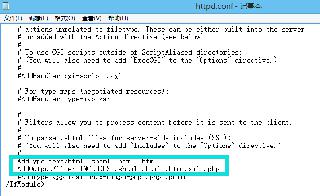
 網(wǎng)公網(wǎng)安備
網(wǎng)公網(wǎng)安備